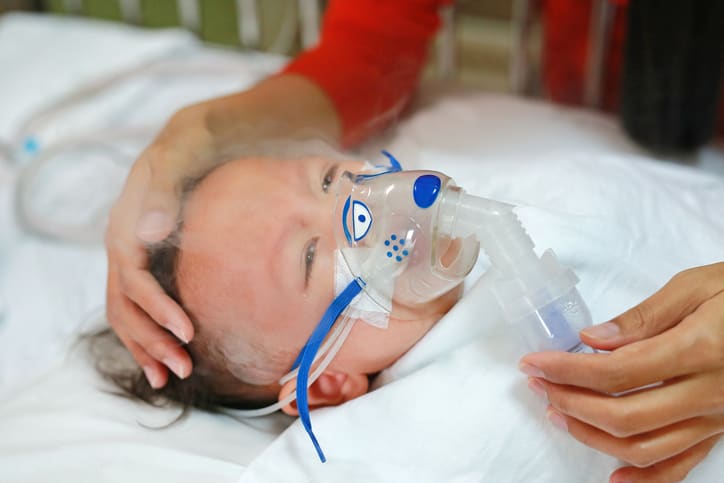Don't scratch that! Tips for managing summer's bug bites

[4 MIN READ]
In this article:
- Most insect bites cause mild to moderate itching and can be treated at home.
- Insect bites can occur anywhere, including in and around your own home.
- Some people may suffer more severe symptoms from insect bites, including trouble breathing, paralysis and more.
Stretches of warm summer weather bring more time outdoors for many of us. It’s important to be safe during our end-of-summer hiking and camping. One thing to be prepared for, whether you’re in the deep woods or near a lake, is a bug bite. Insects such as spiders, ticks and fleas can bite leaving you with annoying itchy bumps or, depending on the bite and what part of the country you’re in, serious illness. To help you figure out whether a bug bite is serious or an annoying itch, we spoke with Bowen He, M.D., a primary care and internal medicine expert at Providence Swedish Redmond Primary Care.
“Most bug bites are not serious and can be managed at home with these general tips. Some people can experience serious reactions to bug bites, including severe pain, infection, and allergic reactions,” says Dr. He. “If you’re worried about how serious the bug bite might be, or if you would like additional advice, you should make an appointment with your PCP or send your doctor a MyChart message.”
First, clean the bite area with soap and water to reduce the risk of infection. Apply over-the-counter hydrocortisone cream or calamine lotion to reduce itching and swelling. If you still have itching, take oral antihistamines like diphenhydramine (Benadryl) or cetirizine (Zyrtec). Applying a cold compress, such as a cold pack or a cloth filled with ice, can help reduce swelling and numb the pain; aim to apply it for about 10-15 minutes. Mild pain can be treated with over-the-counter ibuprofen or acetaminophen. Try to avoid scratching the bite as best as you can, as this can increase the risk of infection and worsen symptoms.
What bit me? An insect bite overview
Insect bites cause your body to have an immune response. Your body will detect the bite as a foreign object and try to flush it out.
Insect bites trigger your immune system to produce histamine, which increases your blood flow and white blood cell count around the affected area. Histamine causes the area around the bug bite to swell and become itchy and sometimes painful.
Spider bites
Spider bites sound scary, but Dr. Lichfield says they aren’t as common as people think. “Many people come into the office convinced they have a spider bite, but often it’s something else. Most spider bites are benign and not poisonous,” Lichfield says.
Spiders can live almost anywhere, including indoors. They tend to be found outdoors in wooded areas but can migrate indoors through plants, animals and cracks around your home. Non-venomous spiders can be beneficial because they eat insects like mosquitos and flies.
Some characteristics of spider bites include:
- Discoloration.
- Redness.
- Small bump or blister.
- Swelling.
- Tiny fang marks or puncture wounds where the spider broke your skin.
The black widow spider and brown recluse spider are the two most dangerous spiders in the United States. Both spiders can be found in undisturbed rocks, leaf piles and under structures. If they wander indoors, you may find them in dark, cluttered spaces. Black widows and brown recluse spiders are venomous so their bites require immediate medical attention.
Black widows – These spiders produce a neurotoxin that causes severe pain at the bite area that spreads throughout the body.
Brown recluse – The venom from a brown recluse spider bite causes stinging pain and destroys the skin tissue around the area. A medical professional will need to clean the bite carefully. If a brown recluse bites you, you may need wound care for several months.
“Insect repellents can be applied to either clothing or skin and you should only use repellants that are registered with the U.S. Environmental Protection Agency (EPA). The only insect repellent currently used for factory treatment of clothing is permethrin which is approved by the EPA. Permethrin has been thoroughly studied and is safe as it is poorly absorbed through the skin. You can also find products containing permethrin used to treat your own clothing,”
Noseums? Identifying flea bites
You may associate fleas with animals. But don't be so quick to blame Fido. However, people can get flea bites as well. Fleas are small wingless insects that travel by jumping from place to place. They live in damp areas around trees, bushes and tall grass. They can jump onto animals or people when they walk by.
Characteristics of flea bites include:
- Bites are commonly on arms and legs.
- Clusters of small, red bumps.
- Red “halo” around the center.
Flea bites cause intense itching and can become painful. You may develop a rash or hives near the affected area. Flea bites will disappear without treatment, but you must eliminate fleas in your home. Fleas can be difficult to get rid of because they lay eggs quickly.
If your pet has fleas, it will need a special bath and topical cream. You can prevent your pet from carrying fleas by keeping them on a year-round flea and tick medication.
You can eliminate fleas around your home with a thorough cleaning that includes:
- Steam cleaning carpets.
- Vacuuming floors, mattresses, couches and chairs.
- Washing all bedding.
Tick bites. Not all ticks are created equal
Different types of ticks can be found in wooded areas throughout the United States. While tick bites are usually painless and cause few symptoms, ticks carry disease. The most common tick-borne diseases are Lyme and Rocky Mountain spotted fever, both bacterial infections. Symptoms of severe Lyme disease and Rocky Mountain spotted fever can be debilitating.
Ticks live in areas with long grass and trees. They also live in areas with decaying leaves and other plant material. Unlike other insects, ticks latch onto your skin. If you find a tick, you should remove it as quickly as possible.
“Finding a tick on your skin does not necessarily mean you will get Lyme disease. However, you should consider a few factors,” says Dr. He. “First, you should remove the tick as soon as possible using proper technique. Use fine-tipped tweezers to grasp the tick as close to the skin's surface as possible. Pull upward with steady, even pressure. Avoid twisting or jerking the tick, as this can cause parts of the tick to break off and remain in the skin.”
“Not all ticks are infected with the bacteria that cause Lyme disease. The likelihood of a tick being a carrier varies by region. Lyme disease is most commonly found in northeastern states such as: Connecticut, Delaware, Maine, Maryland, Massachusetts, New Hampshire, New Jersey, New York, Pennsylvania, Rhode Island, and Vermont,” he adds. “The upper midwestern states of Minnesota and Wisconsin also have higher rates of Lyme disease. It is quite rare in the Pacific Northwest, including Northern California, Oregon and Washington. If you develop symptoms like rash (especially one that looks like a bull's-eye), fever, chills, headache, fatigue, muscle and joint aches, and swollen lymph nodes or are concerned about the tick bite, you should contact your primary care practitioner for advice.”
Signs you should see a provider for a tick bite include:
- A red bullseye rash around the tick bite.
- Flu-like symptoms after removing the tick.
- Pus draining from the wound.
- Red streaks around the affected area.
Your provider will examine your tick bite and prescribe an antibiotic if necessary. If you still have the tick, bring it to your appointment.
First aid and treatment for insect bites
Most insect bites, including mosquito bites and chigger bites, are easily treated at home with over-the-counter antihistamine creams. Try not to scratch! If the area is irritated by scratching be sure to wash it gently with mild soap to remove and dirt and minimize infection.
“Then pat the area dry with a clean towel. Cover the bites with a clean, non-stick bandage or sterile gauze pad to protect them from further scratching. To reduce itching apply a cold compress or an ice pack wrapped in a cloth to the bites for 10-15 minutes to reduce itching and swelling,” Dr. He advises. “An over-the-counter hydrocortisone cream or calamine lotion can also help reduce itching, but you should avoid applying these creams to open wounds.”
Many insects such as mosquitos, are mostly harmless and cause itchiness. If you have an insect bite, it's important to clean the area well with soap and warm water. You should also:
- Remove any part of the insect, including stingers.
- Ice the bite site with a cold compress or ice pack to decrease swelling.
- Apply hydrocortisone lotion to the area to minimize itchiness and swelling.
- Take over-the-counter pain medication, such as Tylenol or Ibuprofen if you have pain.
Treatments for more severe insect bite reactions include:
- Antibiotics
- Epinephrine
- Steroids
Some people experience a severe allergic reaction or anaphylaxis to an insect bite. Symptoms that could indicate a life-threatening reaction include:
- Dizziness
- Extreme fatigue
- Shortness of breath, difficulty breathing
- Swelling of the lips, face or eyes
- Vomiting
- Preventing insect bites
When it comes to bug bites, prevention is key. Fortunately, there are several ways you can prevent insect bites. Some ways to help keep biting critters away include:
- Avoiding wearing perfume or other scented products.
- Tucking pants into your socks.
- Using insect repellants containing DEET.
- Wearing loose-fitting clothing, including long sleeves and pants.
- Wearing a wide-brimmed hat.
“Insect repellents can be applied to either clothing or skin and you should only use repellants that are registered with the U.S. Environmental Protection Agency (EPA). The only insect repellent currently used for factory treatment of clothing is permethrin which is approved by the EPA. Permethrin has been thoroughly studied and is safe as it is poorly absorbed through the skin. You can also find products containing permethrin used to treat your own clothing,” Dr. He advises. “Insect repellants that are applied to the skin include DEET, picaridin, oil of lemon eucalyptus, and IR3535. These are all registered with the U.S. Environmental Protection Agency (EPA). Avoid using any insect repellents that are not registered with EPA as their safety and effectiveness have not been tested thoroughly”
Learn more and find a physician or advanced care practitioner (ACP)
Whether you require an in-person visit or want to consult a doctor virtually, you have options. Contact Swedish Primary Care to schedule an appointment with a primary care provider. You can also connect virtually with your clinician to review your symptoms, provide instruction and follow up as needed. And with Swedish ExpressCare Virtual you can receive treatment in minutes for common conditions such as colds, flu, urinary tract infections, and more. You can use our provider directory to find a specialist or primary care physician near you.
Information for patients and visitors
Additional resources
H 2 Oh man it’s hot! Tips for staying safe when outdoor temperatures rise.
Keep your kids safe and healthy this summer
Choosing care: emergency department, urgent care, or primary care?
What vaccinations do you need to get this fall?
This information is not intended as a substitute for professional medical care. Always follow your health care professional’s instructions.
Providence Swedish experts in the media
Follow us on Facebook, Instagram and X.



